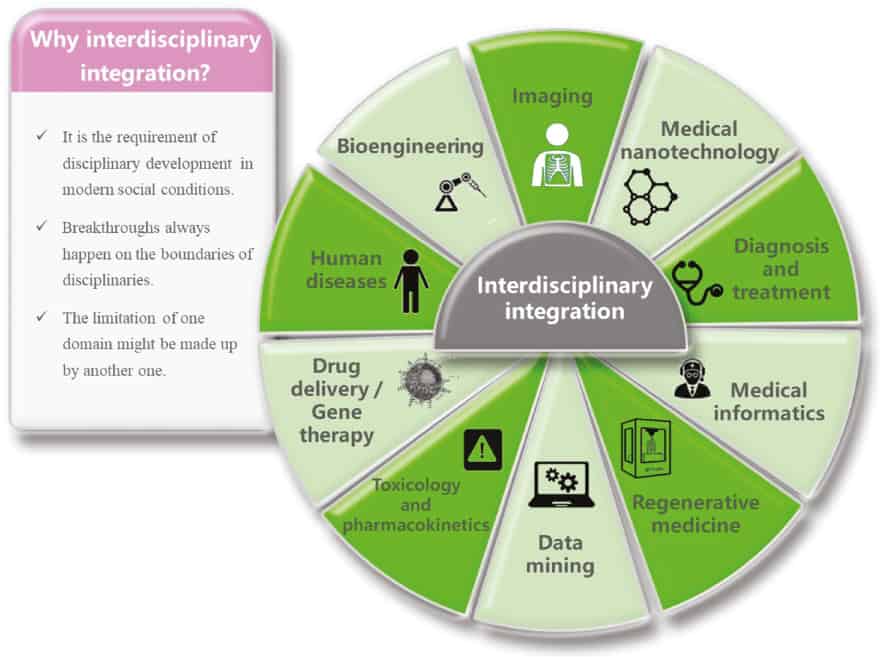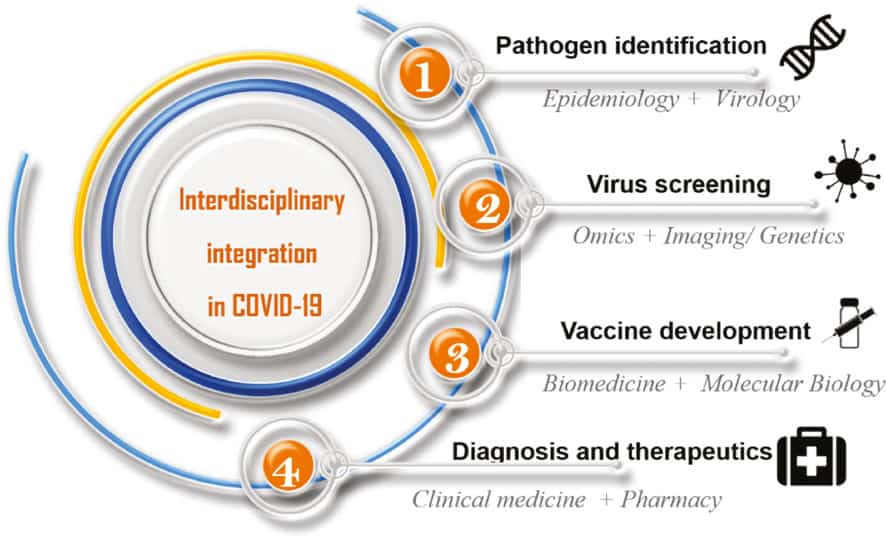The Significance of Interdisciplinary Integration in Academic Research and Application
The Significance of Interdisciplinary Integration in Academic Research and Application
1Guangdong Provincial Key Laboratory of Malignant Tumor Epigenetics and Gene Regulation, Medical Research Center, Sun Yat-sen Memorial Hospital, Sun Yat-sen University, Guangzhou 510120, People’s Republic of China
2Department of Respiratory Medicine, Sun Yat-sen Memorial Hospital, Sun Yat-sen University, Guangzhou 510120, People’s Republic of China
*Correspondence to: Shanping Jiang, Sun Yat-sen Memorial Hospital, Sun Yat-sen University, Guangzhou 510120, China. E-mail: jiangshp@mail.sysu.edu.cn
Received: March 29 2020; Revised: April 2 2020; Accepted: April 7 2020; Published Online: April 11 2020
Cite this paper:
Phei Er Saw, Shanping Jiang. The Significance of Interdisciplinary Integration in Academic Research and Application. BIO Integration 2020; 1(1): 2–5.
DOI: 10.15212/bioi-2020-0005. Available at: https://bio-integration.org/
Download citation
This is an open access article distributed under the terms of the Creative Commons Attribution License (https://creativecommons.org/licenses/by/4.0/). See https://bio-integration.org/copyright-and-permissions/
Introduction
In the light of the rapid development of science and technology, the lingering question is – what does academia lack? The answer may be “effective integration”. Scientific problems are complicated and often interdisciplinary, which implies that in-depth collaboration among experts in various fields is vital. Interdisciplinary research is the essence of social development, innovation and gaining a broader perspective in problem solving. The mission of interdisciplinary integration is to break down barriers, reorient insights, and to produce significant breakthroughs in academic research.
The current status
Interdisciplinary integration is not a novel concept, and it is the key for innovation. In 2015, Nature launched a special issue themed “Interdisciplinarity”, that concentrated on the views of interdisciplinary integration through different perspectives outside academia. Although the authors held different views of what interdisciplinary meant and debated the challenges and opportunities brought by the convergence of multiple disciplines, most if not all agreed on the importance of integration (Figure 1). The question now is how to better appreciate its value. Personal experience tells us that while, on the one hand, we look forward to engaging in collaborations, on the other hand, we are afraid that a temporary exhilaration that might end in disappointment. We now realize that interdisciplinary integration is the key to successful scientific collaboration. However, there are valid concerns such as labor costs, division of funding and, time and energy consumption in the attempt to develop successful interdisciplinary research [1].
FIGURE 1 | The significance of interdisciplinary integration in the advancement of bioscience and medical research.
Tackling a global crisis
“Interdisciplinary integration” indicates that scientists, researchers, and the community must work together to resolve global issues. Currently, the world is experiencing a coronavirus outbreak. On 11th March 2020, the World Health Organization (WHO) declared COVID-19 to be a global pandemic. How can interdisciplinary integration play a role in the light of this global public health emergency?
Case study: Interdis ciplinary integration in COVID-19 research
Although the outbreak has only been underway for a short period of time, many related papers have been published through the different approach of fast publication during in this exceptional time [2]. This research is mainly divided into three areas: epidemiology [3], medical diagnosis and therapeutics [4], and virology [5]. It is clear that single-discipline investigation is inadequate to respond to the global outbreak of COVID-19, therefore interdisciplinary integration is being used in pathogen identification, virus screening, and vaccine development. Methods, ideas, and technologies of different domains have been extensively integrated to achieve new breakthroughs in the detection, prevention, and treatment of the disease.
One striking example is the combination of artificial intelligence (AI) and genetics or radiology. Some researchers have used AI methods and omics technology to detect and find the natural hosts of COVID-19. By finding the potential information in DNA sequences or computed tomography (CT) images, these methods have provided a brand-new strategy for investigating the virus. There have been other studies undertaken by multi-omics methods to fully screen or detect the virus [6]. Moreover, the latest research product named the “Intelligent Throat Swab Collecting Robot”, an idea that emerged from a collaborative research effort by the Chinese pulmonologist Nanshan Zhong and the Shenyang Institute of Automation at the Chinese Academy of Science, had recently been put into use. This robot can automatically collect throat swab samples from patients. Clinicians can control the system remotely, which avoids close contact with patients and protects clinicians from being infected. As all the operations are fully automated, the collecting efficiency and repeatability of the pharyngeal tissue samples will also be improved. Considering the shortage of medical staff, the development of intelligent robots for drug delivery and health monitoring might become a necessity. This indicates that medical robots may be developed not only for sample collection of infected patients, but also for non-infection emergency treatment in the future, such as consultation or pre-screening, sampling, testing, and analysis. We believe that the increasing research achievements of interdisciplinary integration will have positive effects on the treatment, prevention, and control of diseases (Figure 2).
FIGURE 2 | Interdisciplinary integration in the course of the COVID-19 outbreak, indicating strong envelopment of integration in all phases of COVID-19 research.
Besides academic research, integration among multiple domains and industries has also been noticeable. During an outbreak, the allocation and mobilization of emergency resources requires the cooperation of various fields. For example, countries or specific areas are being locked down in order to control the speed of spread. In these areas, public gatherings are banned, and schools are closed. The rapid development of Internet speed (such as the 5G network) will now play an indispensable role in sustaining the basic needs of the society. Doctors can team up to form multi-disciplinary treatment teams, discussing patient’s prognosis, making real-time diagnoses, and giving timely advice – all through online consultations, which greatly speeds up disease control; and also bring us one step closer to realizing precision medicine. This advancement of technology not only brings convenience, it becomes a necessity in the face of a global outbreak. Integration of social and academic resources is the fastest way to overcome the crisis.
Realization of integrative research
For “integration” to be effective, it is important to understand which attempts, and importantly why some attempts, at interdisciplinary integration succeed. Take modern biomedical sciences for example, the success of this multi-disciplinary field depends on the integration among genomics, transcriptomics, and proteomics, etc., and how these omics data combined [7]. Even neuroscience research requires long-term interdisciplinary collaborations with theoreticians, mathematicians, and physicists to fully explain a neurobiological process [8]. For another, the integration of data science, molecular medicine, and clinical medicine is considerable to realize personalized medicine [9]. Multi-centric clinical trials are now prevalent due to the availability of big data and data diversity.
A successful integration needs the accurate prediction of future developing trends, and therefore should not be rushed. Time consumption is mainly dependent on whether the management and evaluation metrics are sound in interdisciplinary integration [10]. For instance, microbiology took many years to find the answers to several questions (such as understanding the mechanisms of the innate immune response, or identifying new pathways) through the integration with genomic and the medical sciences [11]. Furthermore, with the fast development of systemic therapies and integrated medicine, the evaluation metrics of some serious diseases are always in the state of dynamic change [12]. Researchers need to create new approaches to solve inherent problems in single domains, and these new approaches require new management systems. These phenomena happen throughout the processes of academic research, including the manuscript peer reviewing process [13]. Establishing a valuation system is crucial, although it takes more time.
Future insight
Regardless of domain, effective integration of diverse scientific disciplines, incorporating perspectives of academia, industry, governmental organization, and rapid translation of these discoveries to the clinics is essential for realizing the potential of the next era of research. Personalized medicine underlines the role of science collaboration as a major innovation driver in modern medical research, however, such scientific collaborations are also subject to relevant challenges because interests, values, and aims often significantly differ between academia and industry. What we have learned from these outbreaks are that the challenges in various domains require the cooperation of experts from multiple fields. Co-operation creates innovation, innovation increases significance, significance results in impacts and impacts shift the paradigms of life.
Acknowledgment
Shanping Jiang is supported by the Emergency Program for Major Public Health Event of the Ministry of Science and Technology, Department of Science and Technology of Guangdong Province of China (2020B111113001), the Emergency Program for Guangzhou Regenerative Medicine and Health Guangdong Laboratory of China (2020GZR110106003) and Tencent Charity Foundation of China.
References
- Bromham L, Dinnage R, Hua X. Interdisciplinary research has consistently lower funding success. Nature 2016;534:684-7. [PMID: 27357795 DOI: 10.1038/nature18315]
- Rubin EJ, Baden LR, Morrissey S, Campion EW. Medical journals and the 2019-nCoV outbreak. N Engl J Med 2020;382:866. [PMID: 31986242 DOI: 10.1056/NEJMe2001329]
- Li Q, Guan X, Wu P, Wang X, Zhou L, et al. Early transmission dynamics in Wuhan, China, of novel coronavirus-infected pneumonia. N Engl J Med 2020;382:1199-207. [PMID: 31995857 DOI: 10.1056/NEJMoa2001316]
- Wang D, Hu B, Hu C, Zhu F, Liu X, et al. Clinical characteristics of 138 hospitalized patients with 2019 novel coronavirus-infected pneumonia in Wuhan, China. J Am Med Assoc 2020;323:1061-9. [PMID: 32031570 DOI: 10.1001/jama.2020.1585]
- Lu R, Zhao X, Li J, Niu P, Yang B, et al. Genomic characterisation and epidemiology of 2019 novel coronavirus: implications for virus origins and receptor binding. Lancet 2020;395:565-74. [PMID: 32007145 DOI: 10.1016/S0140-6736(20)30251-8]
- Li L, Qin L, Xu Z, Yin Y, Wang X, et al. Artificial intelligence distinguishes COVID-19 from community acquired pneumonia on chest CT. Radiology 2020;200905. [PMID: 32191588 DOI: 10.1148/radiol.2020200905]
- Manzoni C, Kia DA, Vandrovcova J, Hardy J, Wood NW, et al. Genome, transcriptome and proteome: the rise of omics data and their integration in biomedical sciences. Brief Bioinform 2018;19:286–302. [PMID: 27881428 DOI: 10.1093/bib/bbw114]
- Frohlich H, Balling R, Beerenwinkel N, Kohlbacher O, Kumar S, et al. From hype to reality: data science enabling personalized medicine. BMC Medicine 2018;16:150. [PMID: 30145981 DOI: 10.1186/s12916-018-1122-7]
- van Dorn A. Joshua Gordon: an interdisciplinary approach to mental health. Lancet Psychiatry 2017;4:279. [PMID: 28347433 DOI: 10.1016/S2215-0366(17)30093-7]
- Brown RR, Deletic A, Wong TH. Interdisciplinarity: how to catalyse collaboration. Nature 2015;525:315-7. [PMID: 26381970 DOI: 10.1038/525315a]
- Mancini N, Peri F, Rescigno M, Zanoni I. Microbiome studies in the medical sciences and the need for closer multidisciplinary interplay. Sci Signal 2020;13:eaba9911. [PMID: 32019901 DOI: 10.1126/scisignal.aba9911]
- Suh JH, Kotecha R, Chao ST, Ahluwalia MS, Sahgal A, et al. Current approaches to the management of brain metastases. Nat Rev Clin Oncol 2020, DOI: 10.1038/s41571-019-0320-3. [PMID: 32080373 DOI: 10.1038/s41571-019-0320-3]
- Nurok M, Gewertz B. Interdisciplinary disease-based peer review: moving quality assurance into the future. JAMA Surgery 2018;153:3–4. [PMID: 29071336 DOI: 10.1001/jamasurg.2017.3809]


